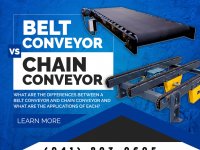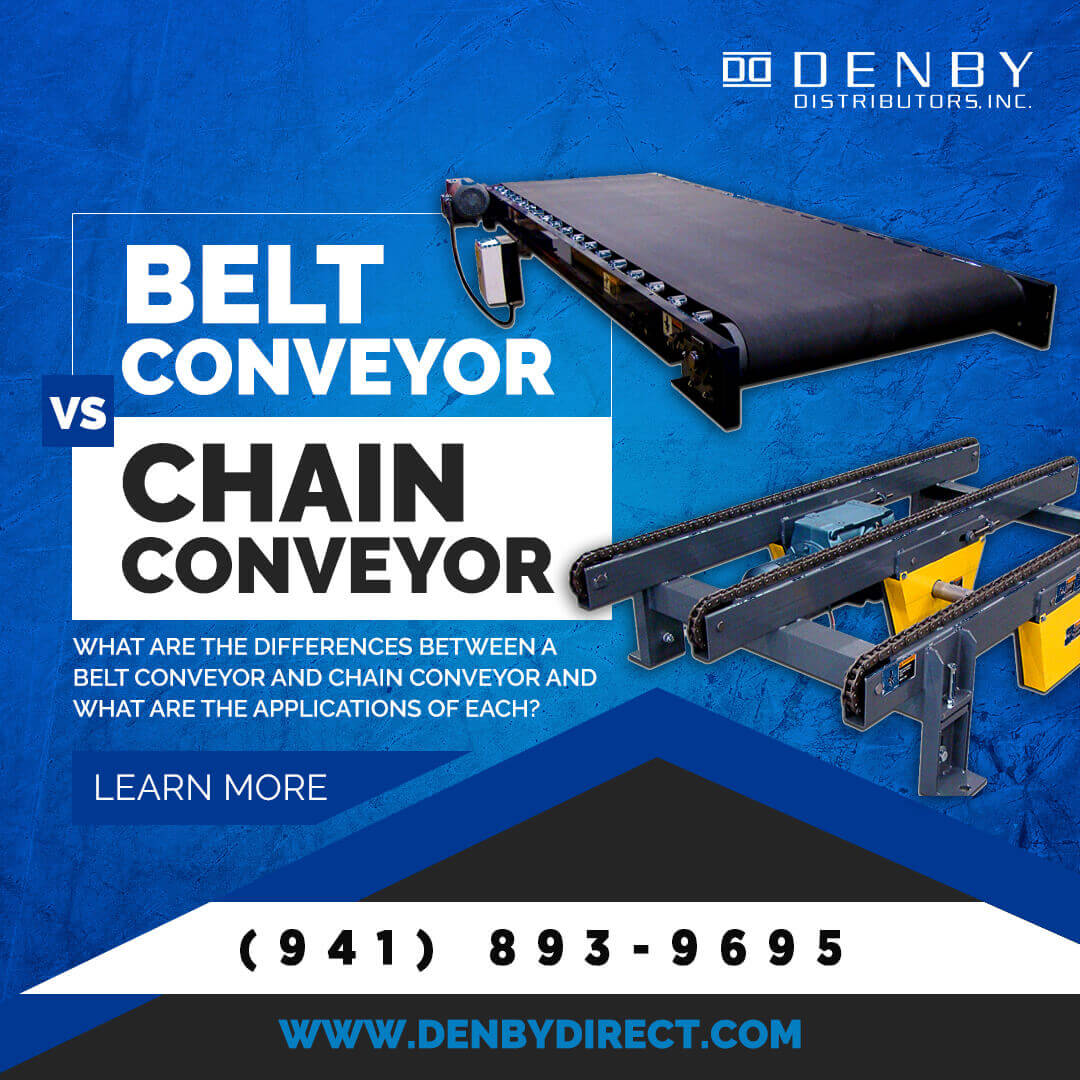Tags: Belt Conveyor, Gravity Conveyor, Best Gravity Conveyor Models, Steel Gravity Rollers, Aluminum Gravity Conveyor
Conveyors are an essential component of assembly lines and are used in various industries. Their purpose is to transfer items within a short or long distance. This process requires little effort and no manpower, allowing business operations to run more efficiently.
However, all conveyors aren't the same, and the proper equipment should be determined by production needs and the type of products being distributed.
With that said, this article will explain the difference between a belt conveyor and a chain conveyor. Continue reading the information below.
What Is a Belt Conveyor?
A belt conveyor consists of two or more pulleys that include an ongoing belt that carries and transports material. The belt is typically made of rubber or PVC, and it rotates around the pulleys in order to move the load. Its pros and cons include:
Pros:
- Cost-effective
- Gently handles products
- Great for batch production
Cons
- Generally not suitable for large, heavy loads
- Easily damaged by abrasive materials
What Is a Chain Conveyor?
A chain conveyor (CDLR) is much like a belt conveyor, but it uses rollers and chain to transport items. The rollers have heat treated sprockets that the chain rides on to create a smooth powerful momentum to accomadate those heavier loads. Its pros and cons include:
Prossnd
- Easy installation
- Minimal maintenance
- Suitable for large, heavy loads
Cons
- Slower, limited speed
- Higher energy consumption
- Not compatible for fragile production loads
Before choosing a conveyor, it’s best to assess which one is most compatible with your business’s products and workload.
Belt Conveyor Vs Chain Conveyor: What’s the Difference?
When it comes to deciding between a belt conveyor or a chain conveyor, it's not about which one is better. It's about the specific production needs for your project and the type of materials that you're moving. As you can see from the information above, both conveyors have pros and cons, and each one is more suitable for certain applications
For instance, one of the best features of a belt conveyor is that it's efficient. If your factory is moving small, delicate items, then a belt conveyor is a good option because it's less likely to damage the products. It also moves at high speeds, making production quicker with fewer errors.
Not only that, but a belt conveyor is also more customizable. You can turn it into a suction belt, magnetize it, backlight it, and more. Plus, a belt conveyor is a lot cleaner than a chain conveyor because it doesn't collect a lot of debris.
So, if your business is within the medical, food, or pharmaceutical industry, a belt conveyor is a good choice.
On the other hand, a chain conveyor (CDLR) works better for product accumulation. Generally, it has less friction than belts, which makes them more suitable for accumulation.
If you need to transport items to a packing station where the workers hand-pack the products, then a chain conveyor allows the items to gather until they are ready for packaging.
Furthermore, a chain conveyor (CDLR) is flexible, so it’s compatible with curved systems. Not to mention, chain conveyors (CDLR) can also move loads a lot better than belt conveyors and are ideal for bulk production flow.
Belt Vs. Chain Conveyor: Things to Consider
When choosing between a belt conveyor versus a chain conveyor, there are four primary product specifications to consider. Here are a few things to think about:
Weight
The weight of your products will determine the type of conveyor belt you need. Think about factors such as the roller gauge requirements, the material for the roller bed, the size of the motor, and other factors.
Also, if the products being transported are heavy, then a durable conveyor belt with a strong motor is required. This is especially true if you are transporting items that are moving horizontally or against gravity.
The Type of Products
What are the items that are being moved made of? Is it wood, metal, glass, or plastic? Let's say your production is transporting wooden boxes. Well, a chain conveyor (CDLR) is best for pushing those types of items along.
And as explained earlier, harsh materials aren’t good for glass, so you shouldn’t pair it with a belt conveyor.
Dimensions
In addition to the weight and type of product you're transporting, think about its size. You'll need to know the dimensions of the items such as their height, length, and width.
Knowing this information will help you to determine which conveyor is the better choice. For large items, you'll need sturdy, wide belts, large roller centers, and a high guide rail to keep the products from falling.
Production Rate
If your business has a high production rate, you'll require something that moves items along quickly. Consider how many products you need to transfer per minute. If you are moving large items, then the conveyor you select should have a suitable speed, as well as a sufficient belt width.
Cleaning
Lastly, think about the cleanup requirements. For instance, in factories that move food, routine clean up is usually required on the conveyor systems.
With that in mind, consider if chemical washes will be performed on the belt and if system parts require dismantling prior to cleaning.
Also, some sections of the conveyor system—like the chains or wire rope slings— might have to be lifted for proper sanitation. Therefore you must consider how the conveyor you choose will work with your business’s wash down regimen.
Get Quality Tools at Wholesale Prices
If your business needs tools and equipment, Denby Distributors has them. We service various industries and provide a variety of products, such as pneumatic tools chisels, belt conveyor products, roller bed accessories, and more.
If you have any questions for us, feel free to call 941-893- 9695 or send us a message online.
We're here to help keep your operation running smoothly.




